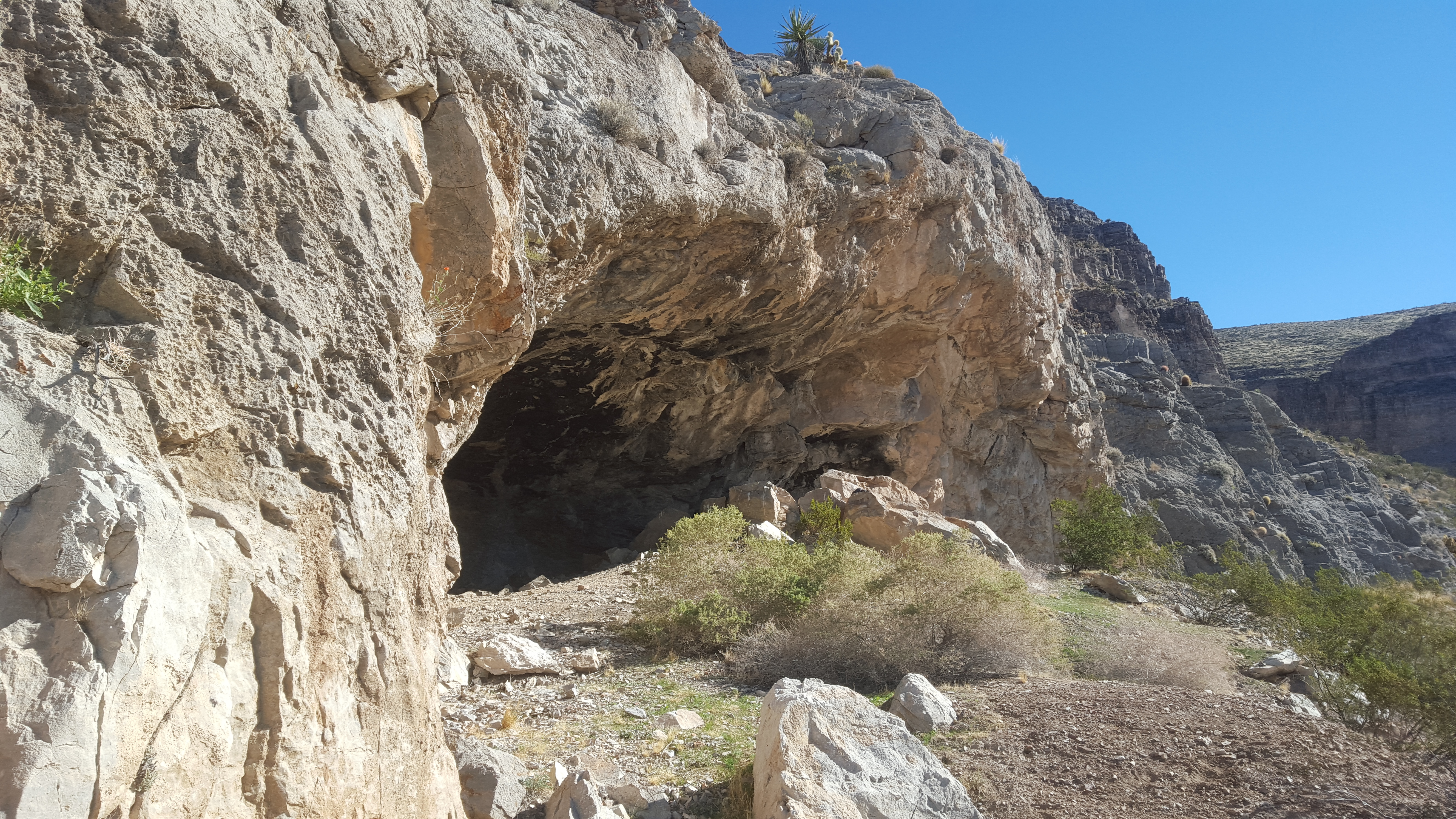
A cave opening at the Mule Springs Rockshelter near Pahrump, Nev. Scott Hamilton-Brehm, assistant professor of microbiology at Southern Illinois University Carbondale, has refined a technique for characterizing ancient human DNA from plant-based artifacts found there. Along with a research team at the Desert Research Institute, Hamilton-Brehm extracted and analyzed DNA from leftover pieces of ancient agave and yucca plant roots used as food by Native Americans who once occupied the area. The findings are being published today in the online open-source science journal PLOS ONE. (Photo provided)
March 09, 2018
SIU researcher’s work sheds light on early Native American migration
CARBONDALE, Ill. – If you want to know about your ancestors today, you can send a little saliva to a company where – for a fee – they will analyze your DNA and tell you where you come from.
For scientists trying to find out about ancient peoples, however, the challenge is a bit grander. But a researcher at Southern Illinois University Carbondale is using an analog to the modern methods to find out more about the genetic ancestry of Native Americans who inhabited the Desert Southwest almost 1,000 years ago.
Scott Hamilton-Brehm, assistant professor of microbiology, has refined a technique for characterizing ancient human DNA from plant-based artifacts. Along with a research team at the Desert Research Institute, Hamilton-Brehm extracted and analyzed DNA from leftover pieces of ancient agave and yucca plant roots used as food by Native Americans who once occupied what is now the Mule Springs Rockshelter near Pahrump, Nev.
The findings are being published today in the online open-source science journal PLOS ONE.
Using DNA to find the way
Hamilton-Brehm’s work, which involves combining targeted mitochondrial DNA analysis with radiocarbon age dating, allows scientists to both identify and date DNA samples found in the southwest.
It also may tell them more about an important, little-understood event in human history known as the Numic Spread, which saw the rapid expansion of those peoples into the Great Basin about 500 to 700 years ago. The Great Basin spans parts of Wyoming, Idaho, Utah, Nevada, Oregon and California, as well as parts of Mexico.
“The distinct advantage of this genetic technique, is that it does not require the sampling of human remains,” Hamilton-Brehm said. “Through genetic screening of quids from southwestern sites, maybe we can determine, on a genetic basis, what the Numic Spread was.”
Ancient diet opens window on the past
During the Late Holocene Epoch, which began 12,000 to 11,500 years ago at the close of the Paleolithic Ice Age and continues today, occupants of the Mule Springs Rockshelter area commonly gathered and roasted the roots of agave and yucca plants before chewing the inner pulp as food. This left husks of stringy fibers called “quids,” which the people simply spit out and left behind. The caves in this area have yielded a great many artifacts over the years, including the quids
During the late 1960s, researchers recovered thousands of quids at Mule Spring Rockshelter, which were then put into storage without consideration for DNA preservation. There the collection sat, unstudied, for more than 50 years.
With the availability of DNA techniques today, Hamilton-Brehm and the team decided to look at the specimens as possible repositories for ancient Native American DNA – the equivalent of the modern-day cheek swab. He and his team selected 21 quids that came from varying depths of excavation in one particular cave for a detailed analysis. Radiocarbon dating showed the specimens ranged in age from about 350 to 980 years old.
The work focused on quids found in one particular cave.
“After the quids were spit out, presumably on the floor of the cave, they get kicked around and then eventually buried,” he said. “The use of the quids was for the nutrients, but may have been also ceremonial. What was quite unusual is that this cave had thousands of quids, more than any neighboring caves in the area. Why so many is not clear to us.”
Methods could lead to better understanding
Hamilton-Brehm used computational resources at SIU to identify groups of single changes in the mitochondrial DNA sequences that are maintained in ancestrally related populations called haplogroups. These haplogroups can then be compared to recognized Native American tribes and other ancient DNA lineages.
These results may provide a better timeline context about an important but contentiously debated event in human history known as the Numic Spread. The samples were found to be about 900 years old, which fits with the time frame of this event.
“This work allows us to really get at some fundamental questions about the Native American occupancy during a time of the proposed Numic Spread,” Hamilton-Brehm said.
The work marked the first time researches could assess the genetic haplogroup distribution from a quid collection, Hamilton-Brehm said. It also provides a survey of genetic information from this area, he said, adding that more work on additional samples is needed.
